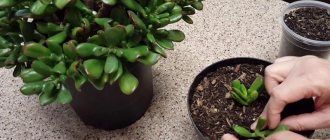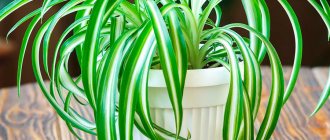Dracaena is becoming an increasingly popular indoor and office plant. She is unpretentious in care, but there are still certain nuances. One of the aspects that you need to pay attention to in order to grow a large, spreading “palm” is regular replanting. How to properly transplant a dracaena into a new pot, and when it is necessary to do this, is discussed in detail in our article.
How to choose soil?
In order for dracaena to feel comfortable in a new place, it needs a well-drained substrate, light, breathable, absorbing a sufficient amount of moisture, with a slight acidity of 6-6.5 pH.
Ready-made earth mixture: pros and cons
The easiest way is to buy a ready-made substrate in a store; choosing soil for dracaena will not be difficult to find. The problem is that most of these soils contain peat. It quickly absorbs water, but hardly releases it, so the soil quickly dries out and the plant does not receive enough moisture.
HELP : As a compromise, you can choose a universal soil for indoor plants. It is suitable for growing dracaena, but still will not be optimal.
How to prepare the soil mixture yourself?
To provide the dracaena with the necessary conditions, it is better to prepare the soil yourself. You can take turf soil as a basis, add leaf soil, humus and coarse sand to it in a ratio of 2:1:1:1.
Cuttings
Beautiful palm trees do not reproduce easily and only by seeds. And dracaena, which is so similar to a palm tree, can be easily grown from cuttings. Both the tops and sections of the stem can be rooted. Thus, you can not only get a new plant, but also rejuvenate the old one.
Unlike capricious palm trees, dracaenas are easy to take cuttings
Planting cuttings
- In an adult and healthy dracaena, use a sharp sterile knife to cut off the stalk by 3–5 cm: the top of the stem with leaves.
In a month or two, the detached cutting will become an independent plant - Fill a small pot with coarse sand or vermiculite, into which you slightly bury the cutting.
- Make a kind of greenhouse, cover the cutting along with the pot with a bag.
- Keep warm (temperature should not be lower than +25 ° C) and in partial shade.
- Spray and ventilate the seedling, water through the pan.
- It takes a month or two for rooting.
Don’t ignore a plant without a crown either. Sprinkle the wound with coal and dry it. Spray the plant with growth stimulants. After 3–4 weeks, new buds will begin to develop under the cut. Dracaena will get a second life.
New shoots appeared on the mother dracaena under the cut
The amazing vitality of dracaena and its ability to reproduce formed the basis of the Aztec legend. According to it, the high priest, who did not want to give his daughter in marriage to a warrior, stuck a stick in the ground and said that if leaves did not appear on it in five days, there would be no wedding. And he promised to execute the groom. The warrior began to water this stick. And on the fifth day leaves grew on it - and thus the dracaena was born. The Aztecs call it the tree of happiness.
Dracaena is also propagated by cuttings of stems up to 12 cm. The sections are dusted with coal, the cuttings are dropped in moistened sand and a greenhouse is set up. Just don't confuse the top end with the bottom. Such cuttings take root in 2–3 weeks.
Some gardeners create original compositions by planting several young dracaenas in one pot. This makes them look more magnificent. However, you should not plant old and young dracaenas together. An adult plant will not allow a teenager to develop.
Rooting dracaena cuttings
Transplantation process
At home, a young dracaena needs to be replanted every year, a slightly older one - once every 2-3 years as the root system grows. There is nothing complicated about it. Before transplanting, you need to prepare everything you need:
- another pot;
- priming;
- drainage;
- scissors or pruning shears.
ATTENTION! Approximately 3 days before transplanting, watering must be stopped. This will make it easier to remove the flower from the old pot.
Soil selection
The soil for transplanting dracaena is an equally important attribute for the comfort of the plant. And although dracaena is not capricious in choosing soil, it likes a nutrient substrate with a neutral or slightly acidic background. It would be nice to add loosening ingredients to it.
In stores you can purchase universal mixtures that are perfect for normal development after transplantation. It is best to buy soil specially prepared specifically for dracaena. Palm soil mixture will also work. Consulting the seller will not hurt in this case.
You can make your own soil. It can be collected from a nearby planting or even from your own garden. Add one part of compost, part of sand and a little humus to 2 parts of soil. For better permeability, it would be good to add chopped moss.
Before transplanting dracaena into your own soil, you need to prepare it. During the cooking process, fungi and larvae that may enter the ground will be destroyed. Sterilization should be carried out in the oven or on the stove. You should not sterilize the soil in a microwave oven: the soil loses its structure, is poorly absorbed by the plant later, and requires a long preparation for planting. Only after a month, when the soil has rested and restored its properties, will it be possible to transplant a dracaena tree into it.
How to choose a pot?
For a dracaena 40–50 cm high, you will need a pot with a diameter of about 20 cm; for each subsequent transplant, you need to choose a container 2–3 cm wider than the previous one. The material and shape of the pot do not play a big role, but clay or ceramic containers, the height of which is slightly greater than the diameter, are considered the most comfortable.
You should not choose a pot that is significantly larger in size than the previous one. The root system of the plant will not be able to immediately absorb too much volume, and this will lead to stagnation of moisture and acidification of the soil.
Is it possible to replant and prune dracaena at the same time?
The issue requires detailed consideration, since most sources categorically do not recommend combining operations. They motivate this by the fact that the plant already receives stress from replanting, and here they also shorten the shoots - the load is too great.
In the spring, the crop tolerates pruning almost painlessly, but quickly awakens new buds, and this is, indeed, an additional burden. If they do not do a full transplant, but a transshipment, the shoot is shortened or not, at the request of the owners.
When completely replacing the substrate, they look at the condition of the roots and the size of the flower. When the underground part is normal, it is better not to touch the trunk, but to water the dracaena after transplantation with a stimulant - Kornevin, heteroauxin.
If you had to clean out rotten areas, shortened sucking shoots can provide nutrition and water supply to a small cutting. But a large dracaena will take on too many plastic substances and will not allow the root system to fully and quickly develop.
The leafy part will have to be cut off. Even if the plant fails, and first of all it does not regenerate the roots, but awakens new buds, the young leaves will quickly dry out. It is better to help them and break them out immediately after swelling.
In summer, dracaena is treated in the same way as in spring. The difference is that before rooting, dormant buds are unlikely to wake up.
Transplanting a crop at the end of the season is always an emergency, associated with serious troubles. Root regeneration is extremely slow; if a flower is forced to expend energy on maintaining the leaf apparatus, this can lead to its death. It is recommended to cut off the above-ground part.
In what cases is a transplant required?
Determining when dracaena needs to be transplanted into a new pot is quite simple. This needs to be done if:
- the time has come for a planned transplant;
- the plant has outgrown the previous pot and roots are visible on its surface and in the drainage holes;
- the soil is chosen incorrectly and is not suitable for dracaena;
- there is a suspicion that the soil is infected with pests, fungus or mold;
- the soil became waterlogged and the roots rotted;
- Excessive fertilization led to plant disease.
ATTENTION! It is better to replant dracaena in early spring. This period is the most favorable, since the plant enters the stage of active growth and most easily adapts to changes.
Step-by-step instructions for transplantation
The sequence of actions is quite simple, if you follow it, there should be no problems.
- Prepare everything you need. Wash the pot and tools with soap and scald with boiling water.
- Carefully remove the dracaena from the old pot and carefully examine the roots. All damaged areas of the roots must be trimmed using pruning shears, and the cut areas must be treated with crushed activated carbon or iodine.
- Place 2–3 cm of drainage at the bottom of the pot, and then add a small layer of soil.
- Place the plant in the center and gently sprinkle with soil so that it fills all the voids between the roots.
- Water thoroughly.
To help dracaena restore damaged roots, you can use one of the plant growth stimulating agents, such as Kornevin or Zircon.
Why the dracaena palm blossomed and died: signs and superstitions
Dracaena palm: signs and superstitions
Dracaena is one of those plants with which many signs and superstitions are associated. For example, it is believed that this exotic plant must be in a house where there is an unmarried girl. Moreover, it should be in her bedroom, and she herself should take care of it. It is believed that if a girl does everything right and the flower feels good, then its positive energy will definitely attract her soulmate to her and this will happen exactly when the palm tree blooms.
If a married woman’s plant is covered with beautiful flowers, then by their number and size she will be able to judge the strength of her husband’s love. It is believed that a large number of large flowers indicates that a man has the strongest feelings for his chosen one. In addition, the lush flowering of a palm tree can promise a person unexpected success. Most often this is associated with an improvement in financial condition, success at work, or a big win in the lottery.
But if your dracaena died with proper care, then you need to prepare for trouble. If the flower dries slowly, this may indicate that all the money will flow out of your house for quite a long time. If the palm tree dies in literally 2-3 days, it indicates that a person close to you will soon die. Moreover, this will not necessarily be your blood relative, it could be a friend or just an acquaintance.
Do I need to replant immediately after purchase?
A flower bought in a store always needs to be replanted, but there is no need to rush into it. If the plant feels good, does not turn yellow and does not show signs of disease, it is better to wait until spring.
In any case, it is necessary to give the dracaena at least 2-3 weeks to adapt to the new conditions, and only after that proceed with replanting, otherwise the plant, weakened by the move, may not tolerate additional stress.
Care after transplant
The rules remain the same, but for a weakened plant it is especially important to maintain temperature and humidity, as well as adherence to the watering regime. It is important to avoid direct sunlight, drafts, as well as excess moisture or drying out of the soil.
Possible problems
If the transplant is unsuccessful, there is a risk of problems. Dracaena may begin to lose its decorative effect. In this case, the foliage will look drooping and yellowed. The reasons for the plant's malaise lie in mistakes made during its replanting and subsequent care. Among them you can see:
- Illiterate selection of soil mixture. The ornamental crop does not do well in heavy and oily soil with a high peat content.
- Using a container larger than required. There is a risk of soil acidification and the development of putrefactive flora.
- Excessive watering of a plant that has undergone transplantation. After replanting, the false palm tree should be watered as the top layer of soil dries. Water should not stand in the pan. If the plant has suffered from excessive watering, it is necessary to dry the earthen ball, having first removed it from the container.
- Non-compliance with the temperature regime in the room. The transplanted dracaena should not be kept in the cold. It needs warm and humid air.
Yellowing and dying leaves
After transplantation, slight yellowing and loss of foliage may be observed within 14 days.
This is normal. If after two weeks the problem worsens, urgent action is required. What happens is provoked by excessive soil moisture or increased fat content and air impermeability. It will be necessary to reduce watering, and in case of urgent need, change the soil to a suitable one.
Dry and darkened tips of leaves are a sign of excessive dry air in the room. The solution to the problem is spraying.
Attention. When kept in cold conditions, the leaves of the false palm may begin to turn black. This complication is also caused by the contact of the green decoration of the plant with cold glass.
The plant has dropped its leaves
Drooping leaves are normal after transplanting dracaena. The plant has experienced stress and needs to be restored. A warm shower will help the false palm return to normal. During the water procedure, waterlogging of the soil should be avoided. It is advisable to cover the soil in the pot with plastic wrap.
Correctly carried out transplantation will help the dracaena to remain healthy and maintain its decorative appearance. It is enough to follow the technique of performing the procedure and properly care for the plant after manipulation.
The procedure for sterilizing the earthen mixture
Sequencing:
- You need to take a container for sterilization with a lid, fill it with soil mixture, lightly water it, cover it and immediately put it in the oven to warm up.
- In order for the soil to warm up well to its full depth, you need to stir it every 10 minutes.
- Set the oven to 100 degrees. When the temperature reaches 100 degrees, reduce the heat and keep the mixture on the fire for another half hour. This is enough time for pathogens and pests to die.











